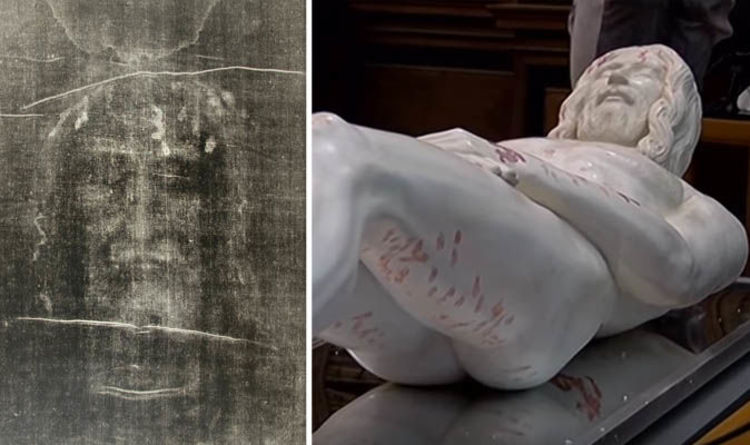The Shroud of Turin is a centuries-old linen cloth that has captured imaginations and sparked debates for generations. Some believe it to be the actual burial shroud of Jesus Christ, while others dismiss it as a detailed scam.
In this article, we are going to talk all about the scientific investigations that have shed light on this mysterious relic.
The Shroud: A Brief Overview
The Shroud of Turin is a piece of linen cloth measuring approximately 14 feet long and 3.5 feet wide. It bears the faint image of a man, it seems imprinted by bloodstains and other markings. According to tradition, this shroud wrapped the body of Jesus after his crucifixion and before his rebirth.
The Controversy
- Bishop Pierre d’Arcis’ Accusation (1390):
- In 1390, Catholic Bishop Pierre d’Arcis wrote a letter to Pope Clement VII, asserting that the shroud was a clever forgery.
- He accused someone of falsely claiming it was Jesus’ actual burial shroud to extract money from the faithful.
- Carbon Dating (1988):
- In 1988, radiocarbon dating was performed on a sample from the shroud.
- The results indicated that the shroud dated back to the medieval period (between 1260 and 1390), not the biblical era.
- Skeptics rejoiced, while believers remained steadfast.
- Forensic Analysis (Recent Studies):
- Scientists continue to examine the shroud using modern forensic techniques.
- Dr. Matteo Borrini (Liverpool John Moores University) and Luigi Garlaschelli (University of Pavia) conducted a study.
- They focused on the apparent bloodstains on the shroud.
The Bloodstains: What Did They Find?
- Blood Patterns:
- The shroud displays what appear to be bloodstains, particularly on the left hand of the ghostly figure.
- Borrini and Garlaschelli analyzed these stains.
- Forensic Experiment:
- They used a living volunteer and both real and synthetic blood.
- Their goal was to simulate how blood from Jesus’ crucifixion and spear wounds might have flowed onto the shroud.
- Inconsistent Blood Spatters:
- The researchers found that the blood spatters could not have been produced by a dead body lying still.
- Instead, they concluded that the stains were consistent with someone moving to adopt different poses.
- Specifically, the forearm bloodstains suggested an upright position with arms at a 45-degree angle (similar to crucifixion).
- However, the shroud’s configuration would require the arms to be held almost vertically above the head.
Origins and Significance
- The Veil of Silence:
- The shroud’s history remains shrouded in obscurity.
- Tradition asserts that it enveloped the lifeless body of Jesus Christ after his crucifixion.
- Its journey from Golgotha to Turin, Italy, is veiled in silence.
- The Ghostly Impression:
- The shroud bears a faint, ghostly image a man with outstretched arms and wounds consistent with crucifixion.
- Some see it as a miraculous imprint of Jesus’ body, while others dismiss it as a medieval forgery.
Latest Articles
- Biocentrism Debunked: Rethinking Space, Time, And Consciousness
- Scientists Debunk Blood of Jesus Found on the Shroud of Turin
Controversies Unveiled
- Radiocarbon Dating Dilemma:
- In 1988, radiocarbon dating placed the shroud squarely in the Middle Ages (1260–1390 AD).
- Skeptics rejoiced, but believers clung to faith.
- Yet, questions linger:
- Could the tested sample have been contaminated?
- Did the dating account for potential repairs over centuries?
- The Bloodstains Enigma:
- Bloodstains adorn the shroud, particularly on the left hand.
- Scientists dissected these crimson imprints.
- Their findings:
- The blood spatters defy a passive, lifeless body.
- Instead, they hint at movement arms raised, perhaps in agony.
- But the shroud’s configuration puzzles: arms aloft, not crucified.
- Artistry or Divine Intervention?:
- Medieval Artisans:
- Skeptics propose skilled artisans meticulously crafted the shroud.
- Their palette: blood, sweat, and ingenuity.
- Miraculous Origin:
- Believers invoke divine intervention.
- Could the Resurrection have imprinted Jesus’ image?
- A celestial brushstroke on earthly fabric?
- Medieval Artisans:
Conclusion
The scientific evidence points away from the Shroud of Turin being the genuine burial cloth of Jesus. While the debate continues, the consensus among experts leans toward the shroud being a medieval forgery.
Whether you’re a skeptic or a believer, the shroud remains an enigma one that continues to captivate our curiosity and challenge our understanding.
People Also Ask
Is the blood of Jesus still flowing?
According to Christian belief, Jesus’ blood has significant spiritual and symbolic meaning. While there is no scientific evidence to suggest that Jesus’ physical blood is still flowing, the concept of His blood remains central to Christian theology. It represents redemption, forgiveness, and salvation.
Does Jesus have DNA?
Jesus, as described in the New Testament, was fully human. Therefore, it is reasonable to assume that He had DNA.
His biological mother, Mary, would have contributed half of His genetic material. However, the exact nature of His DNA remains a mystery.
Are there descendants of Jesus?
The idea of Jesus having direct descendants is a topic of speculation and debate. Some theories propose that Jesus married Mary Magdalene and had children, leading to a lineage.
However, this claim lacks historical evidence and is generally dismissed by scholars.
Is there actual blood on the Shroud of Turin?
The Shroud of Turin, believed by some to be the burial cloth of Jesus, contains reddish stains consistent with crucifixion wounds. Scientific analysis has revealed iron oxide in these stains, which could be from pigment or blood.
However, radiocarbon dating places the shroud’s origin between 1260 and 1390 CE. The authenticity of the blood stains remains inconclusive, and the shroud continues to be a subject of fascination and debate.

I am a passionate technology and business enthusiast, constantly exploring the intersection where innovation meets entrepreneurship. With a keen eye for emerging trends and a deep understanding of market dynamics, I provide insightful analysis and commentary on the latest advancements shaping the tech industry.
